Here’s my guide to visiting Pienza Italy, a stunning UNESCO-listed town in Tuscany. You’ll find all the top attractions and best things to do in Pienza.
Pienza is located in the gorgeous Val d’Orcia region of central Tuscany, where cypress trees line winding roads and sun-bleached valleys.
Pienza is known as the first “ideal Renaissance town.” It was the brainchild of Enea Silvio Piccolomini, who would later become Pope Pius II.
Piccolomini hired the architect Bernardo Rossellino. Rossellino used the principles of Renaissance town planning set forth by his mentor, Leon Battista Alberti, in his treatise on architecture.
The result?
A town that perfectly expressed the Renaissance canons of art and architecture. Pienza is one of Italy’s most beautiful towns with narrow streets, beautiful palaces, churches, and buildings.
Flowers bloom everywhere, completing the picturesque ensemble. The streets even have romantic names like Love Street and Kiss Street.
History of Pienza: The Piccolomini and the Pope
The Piccolomini were an important Tuscan family.
Enea became Pope Pius II in 1458. His nephew became Pope Pius III. The only other Italian family that produced two popes was the Medici.
READ: History of the Medici Dynasty
The Piccolomini were renowned in Siena. They were responsible for the Piccolomini Library in the Siena Cathedral complex.
Pienza began life as a rural farm town. After Enea became pope and with plenty of cash, he decided to transform the village in which he was born, Corsignano.
Piccolomini was considered a humanist pope. He left behind a unique biography. He was interested in the Greco-Roman antiquities. He was a poet and patron of early Renaissance art.
Piccolomini’s greatest historic legacy was the Council of Mantua in 1459. This was his attempt to muster military support for one last crusade to free Constantinople from the Ottomans.
READ: Guide To Mantua
But his greatest artistic legacy was transforming Corsignano into Pienza. He wanted to produce an “ideal Renaissance city.” And he succeeded masterfully, re-naming the town (rather vaingloriously) after himself.
Architects of Pienza
At the time, there was a lot of architectural theory floating around. The most famous treatise was written by Leon Battista Alberti.
Alberti was good friends with Renaissance luminaries — Brunelleschi, Donatello, and Leonardo da Vinci.
READ: Guide To the Paintings of Leonardo da Vinci
Alberti was the architect of the facade of Santa Maria Novella in Florence. Alberti wrote about how building and cities should be build. His aesthetic theories of proportionality and harmony that revitalized classicism.
Pienza was an ideal location for this experiment. Corsignano was small enough that the pope could roll on in there and rebuild.
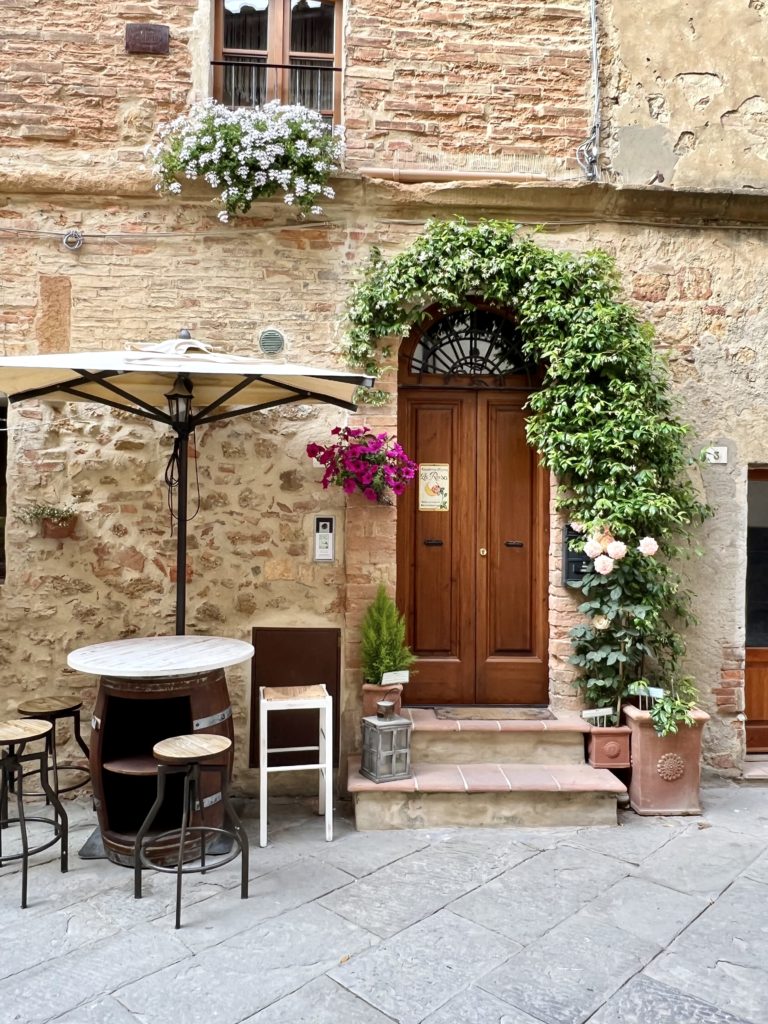
The pope produced a beautiful cluster of buildings in the center of town. Pienza is tantamount to an architectural stage set.
To accomplish this feat, the pope hired Bernardo Rossellino. Rossellino was in Alberti’s inner circle.
Rosselino was the onsite architect. But many consider Alberti the guiding light of the Pienza project.
Rossellino was from Florence. Not much was happening in nearby Siena at that time.
The early Renaissance blossomed in Florence. Though the Florentine were resented by some of the Sienese.
READ: Masterpieces of Florence
Guide To Pienza: What To See And Do
Here are the top attractions and best things to do on a visit to Pienza.
1. Piazza Pio II
Pienza’s main square is the splendid Piazza Pio II. The trapezoidal square is wrapped with Pienza’s most impressive monuments.
There are circles in the pavement where you can stand to have the ideal viewing point of all the monuments.
The space available to Rossellino was limited. To increase the sense of perspective and dignity of the monuments he designed, Rossellino set them off at angles to the cathedral around a magnificently paved piazza.
In the piazza, you’ll also find a travertine cistern or well. This was where the citizens could draw water.
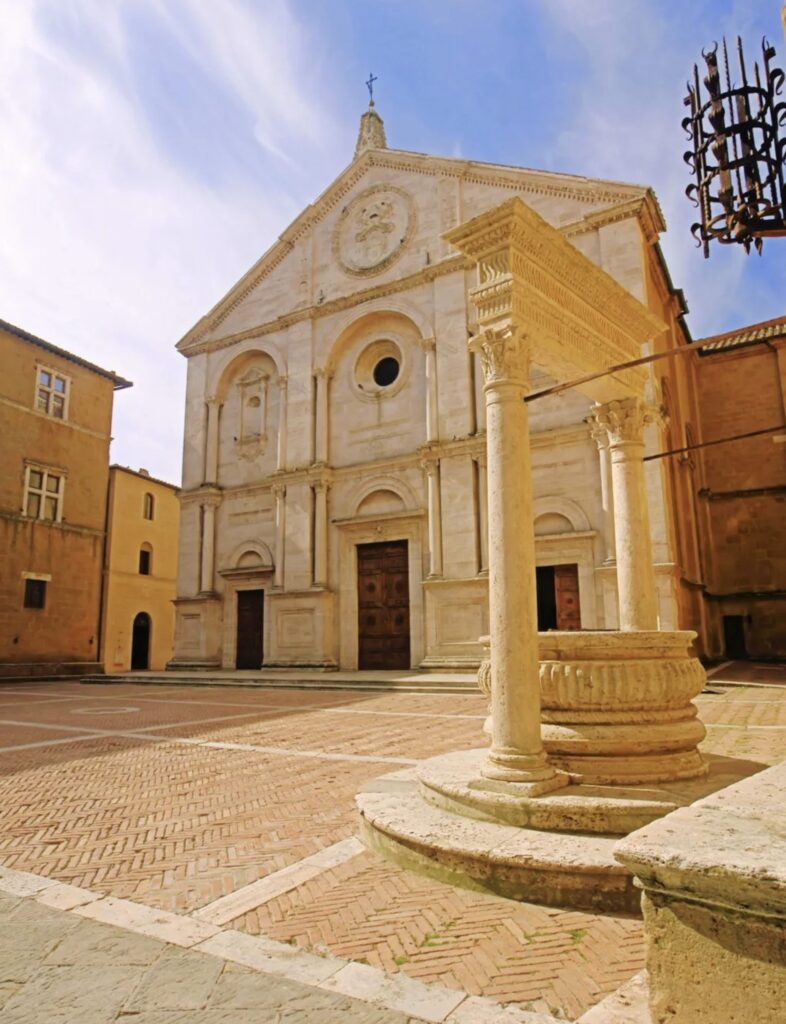
2. Pienza Cathedral
Pienza Cathedral is officially known as the Cathedral of Santa Maria Assunta. It’s perched on a precipice. The back side of the church is slipping off somewhat, and there’s been interventions to save it.
The classically-inspired facade is made from travertine marble. The triple-arched facade recalls ancient Roman triumphal arches.
The round window at the center — dubbed the “Great Eye of the Cyclops” by the pope — matches an identical stone eye in the piazza.
Behind the marble temple facade lies a high vaulted Gothic style church. The church has a basilica plan, which makes it look like a large hall.
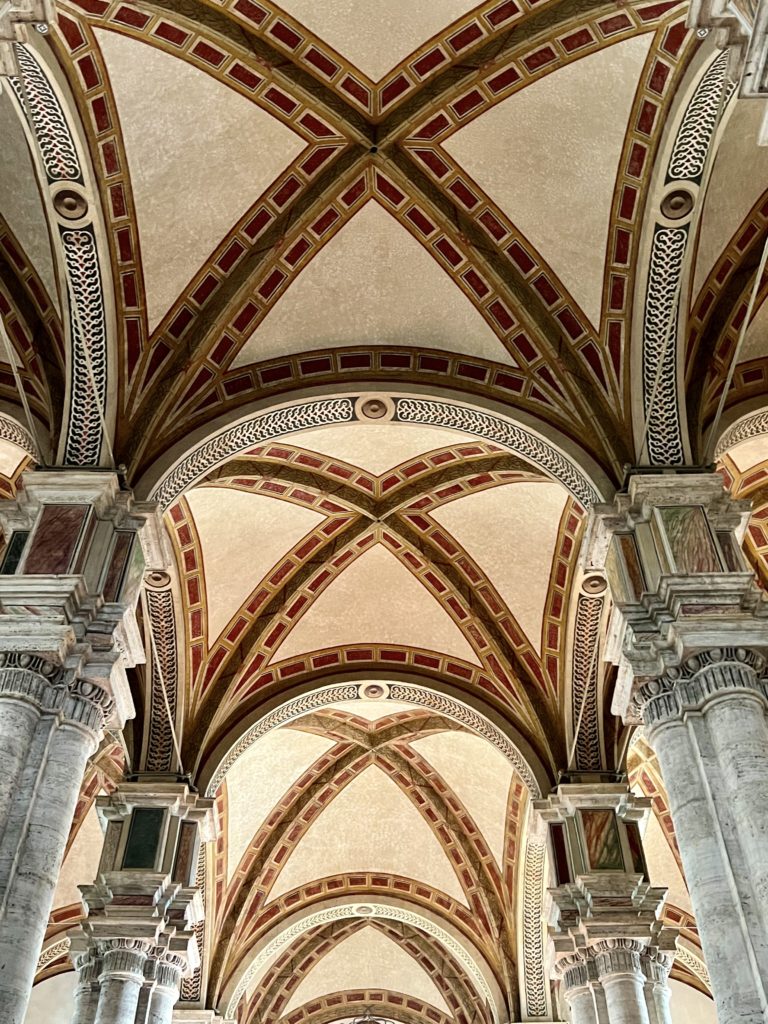
The roof level is the same for the nave and the two side aisles. Chapels radiate around the high altar.
The cathedral is “signed.” In a pilaster, you can see a crayfish relief. That was the family symbol of Rossellino, who’s real name was Gamberelli (meaning shrimp in Italian).
Inside, it’s airy, beautiful, and well-illuminated. Illustrious Sienese artists decorated the church with magnificent altarpieces.
The Baptistry, dedicated as usual to St. John the Baptist, is located next to the apse. There’s a medieval baptismal font.
3. Piccolomini Palace
Visiting the Piccolomini Palace is one of the best the vest things to do in Pienza. It was the domestic summer residence of the Piccolomini family. It’s a large block palace, just like the palaces in Florence. There’s a bench running along the outside.
The overall look is harmonious. The builders used rusticated stone. The palace is three stories high, with pilasters articulating the stories.
The inspiration for this palace was the Palazzo Rucellai in Florence, whose design is attributed to Alberti. The 23 windows are mullioned, with a horizontal sandstone band inside.
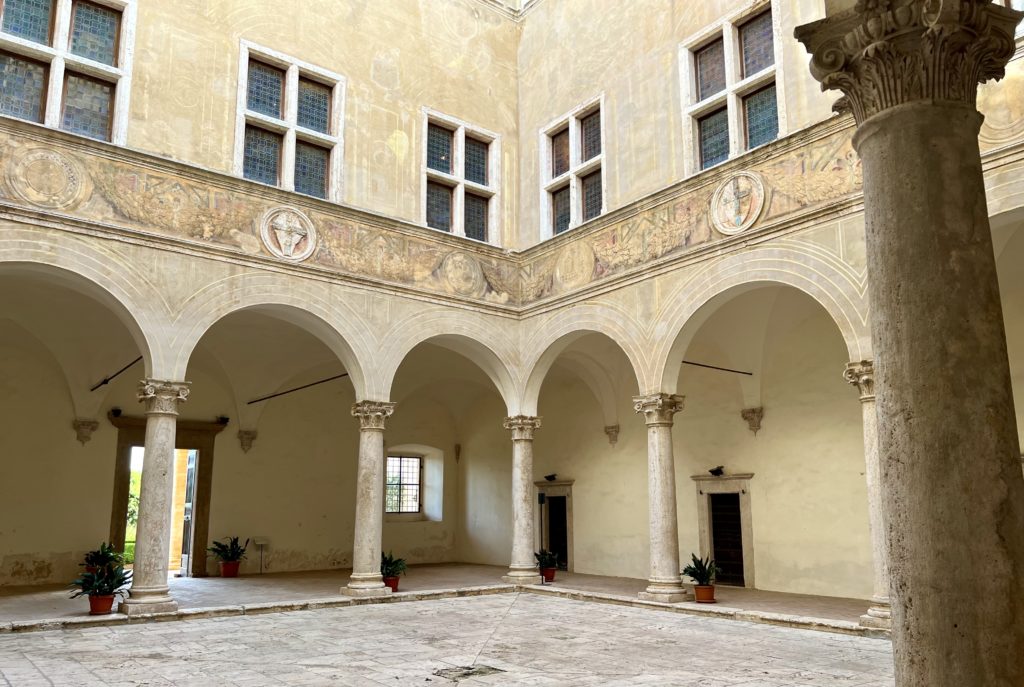
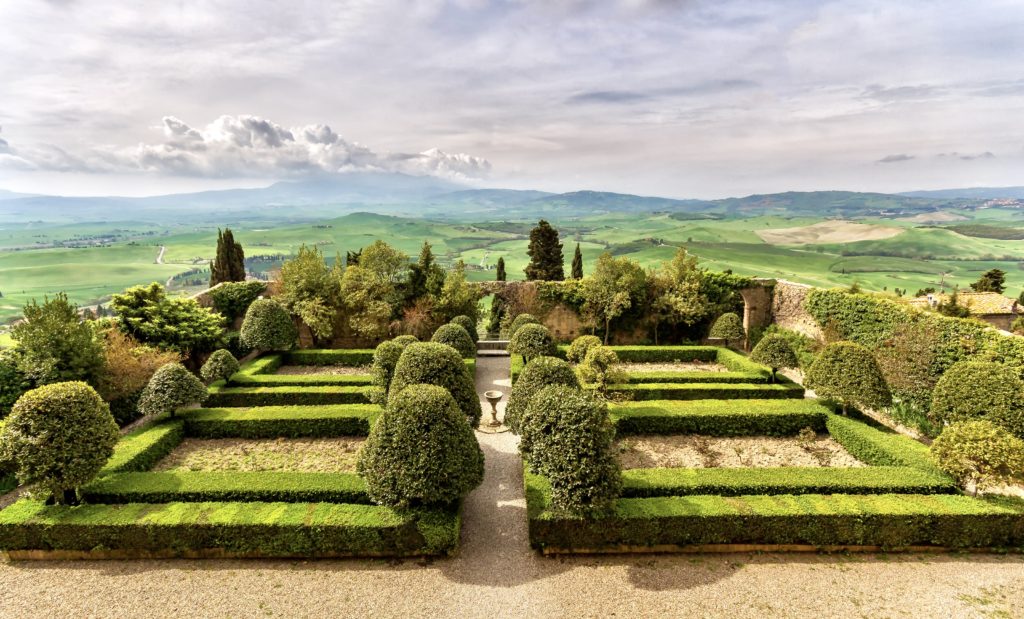
Inside the palace, you can see some of the well preserved period rooms, including the pope’s bedroom.
The furniture is original. You can inspect the family’s collection of treasures.
The palace has a wonderful loggia on the second floor, from which you have breathtaking panoramas of Mount Amiata and the Val d’Orcia.
There’s also an ivy clad hanging garden on the south side, which you see from the loggia. It was one of the first “roof gardens” of the Renaissance.
Click here to pre-book a ticket to the palace.
4. Bishop’s Palace | Palazzo Vescovile
This is the most simple building in the square, to the right of the cathedral. It was built to house the bishops who were visiting the pope.
The Bishop’s Palace is also three stories. There’s a large door flanked with rectangular windows. Cruciform or “Guelph cross” windows are on the second and third floor.
It’s a rather nondescript building. But (naturally) it had to be less grand than the Piccolomini Palace and Pienza Cathedral.
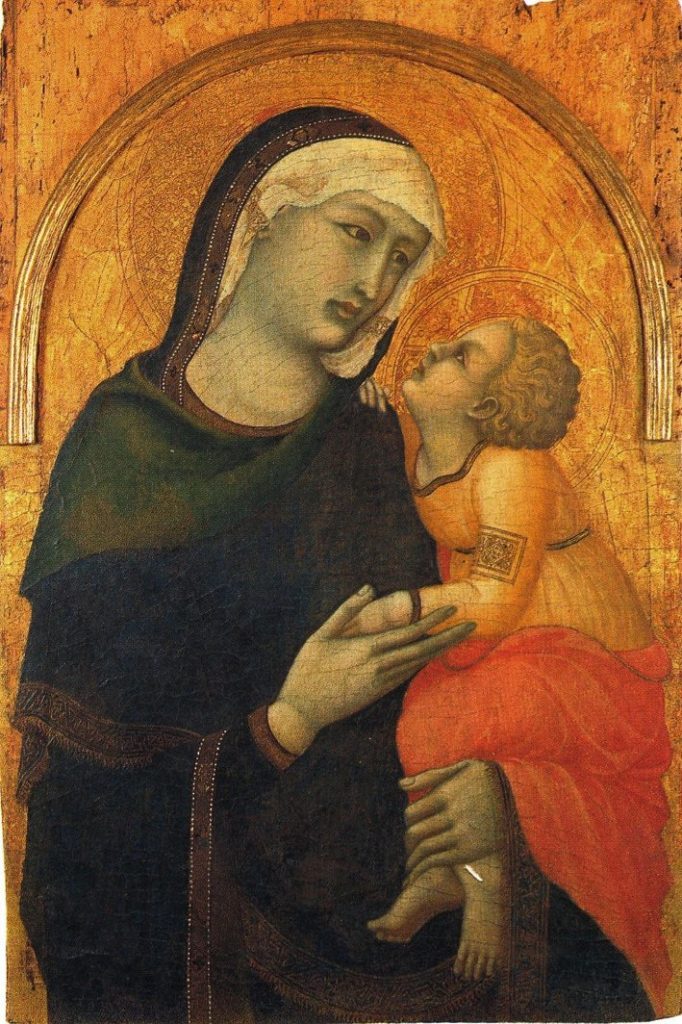
5. Diocesan Museum
Housed in the Palazzo Borgia, the Museo Diocesano displays an eclectic array of artworks, illuminated manuscripts, religious artifacts, tapestries, and miniatures.
Highlights include Pietro Lorenzetti’s Madonna col Bambino, Bartolo di Fredi’s Madonna della Misericordia, and the Gothic style Cope di Pius II.
The latter is an early 14th century embroidered cloak depicting the stories of the Virgin Mary, Margaret of Antioch, and Catherine of Alexandria.
There’s also a madonna attributed to Luca Signorelli.
6. Town Hall | Palazzo Comunale
The Palazzo Communale is the civic palace of Pienza. It faces Pienza Cathedral.
The bottom level is a triple arched loggia with Ionic columns, much like the Loggia dei Lanza of the Palazzo Vecchio in Florence. The loggia is covered with the coats of arm of the mayors of Pienza and the Piccolomini.
The second floor has four bifurcate windows. There’s a dominating terracotta clock tower, characteristic of a town hall.
It’s slightly shorter than the cathedral’s bell tower, intended to indicate the superior power of the church.
7. Passeggiata Panoramica
The Passeggiata Panoramica is a natural path along the edge of Pienza’s town walls. It offers a stroller wonderful views over the Val d’Orcia, making it one of the best things to do in Pienza.
Along the route, you’ll encounter various viewpoints and strategic spots from which you can admire the sweeping vistas and snap some photos.
The path ends briefly at the walls of the cathedral, but resumes again at the other side.
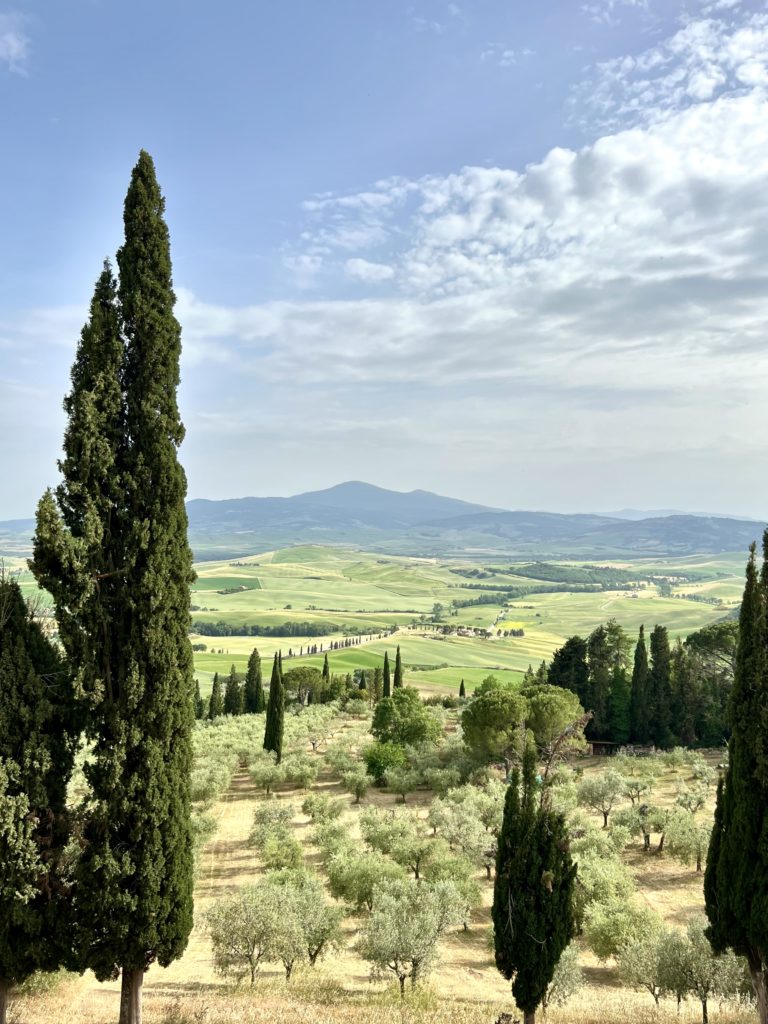
8. Pieve di Corsignano Church
Just a short stroll from Pienza is a beautiful example of Romanesque architecture, Pieve di Corsignano.
It’s an unspoiled and spartan jewel from the 12th century, with a little mermaid over the door.
The church has a unique circular bell tower with eight arched windows. The baptismal font is where Pope Pius II was baptized.
9. Palazzo Massaini
Just 5K outside Pienza on a nearby hilltop is the Palazzo Massaini. It boasts spectacular 360 degree view of the Tuscan landscape.
This is one of Italy’s Agriturismo places to stay. An agriturismo is when you stay in a farm or farm house resort, eating fresh farm produce.
There is a main rusticated palace (where you check in) and stone farmhouses on the estate.
10. Tips For Exploring The Best Things To Do In Pienza
How To Get To Pienza
Pienza is an easy day trip from Siena (1 hour) or from Montepulciano (20 minutes).
If you start early, you can combine Pienza and Montepulciano in one day.
You can book an 8 hour guided tour of Montepulciano and Pienza from Florence. Or book a 10 hour guided wine tour from Florence that includes both towns.
There’s also a private wine tour from Siena. You can even book a wine and cheese tour in Pienza from Rome.
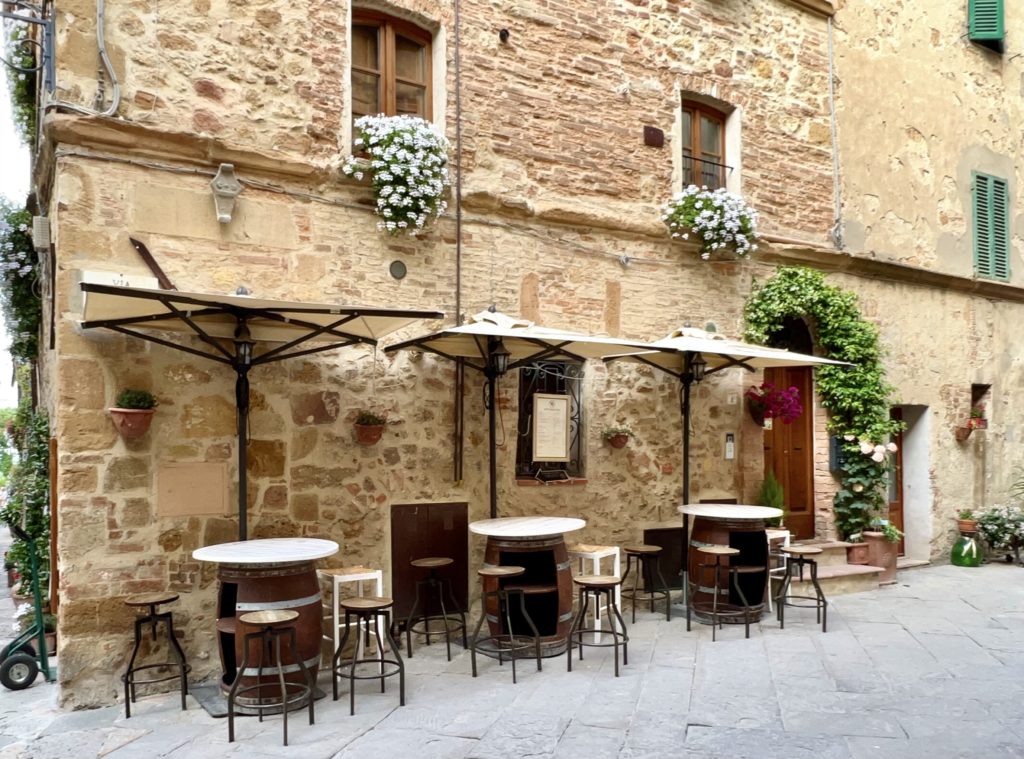
Pienza can also be visited from Florence. It’s a 1.5 hour day trip by car.
If traveling by car, park in one of the lots outside the old town walls. Or, you may find free spots on streets near the entry to the centro storico.
Pienza makes a great base for exploring southern Tuscany. The town is small and eminently scrollable. But it has some great restaurants and plenty of things to do and see.
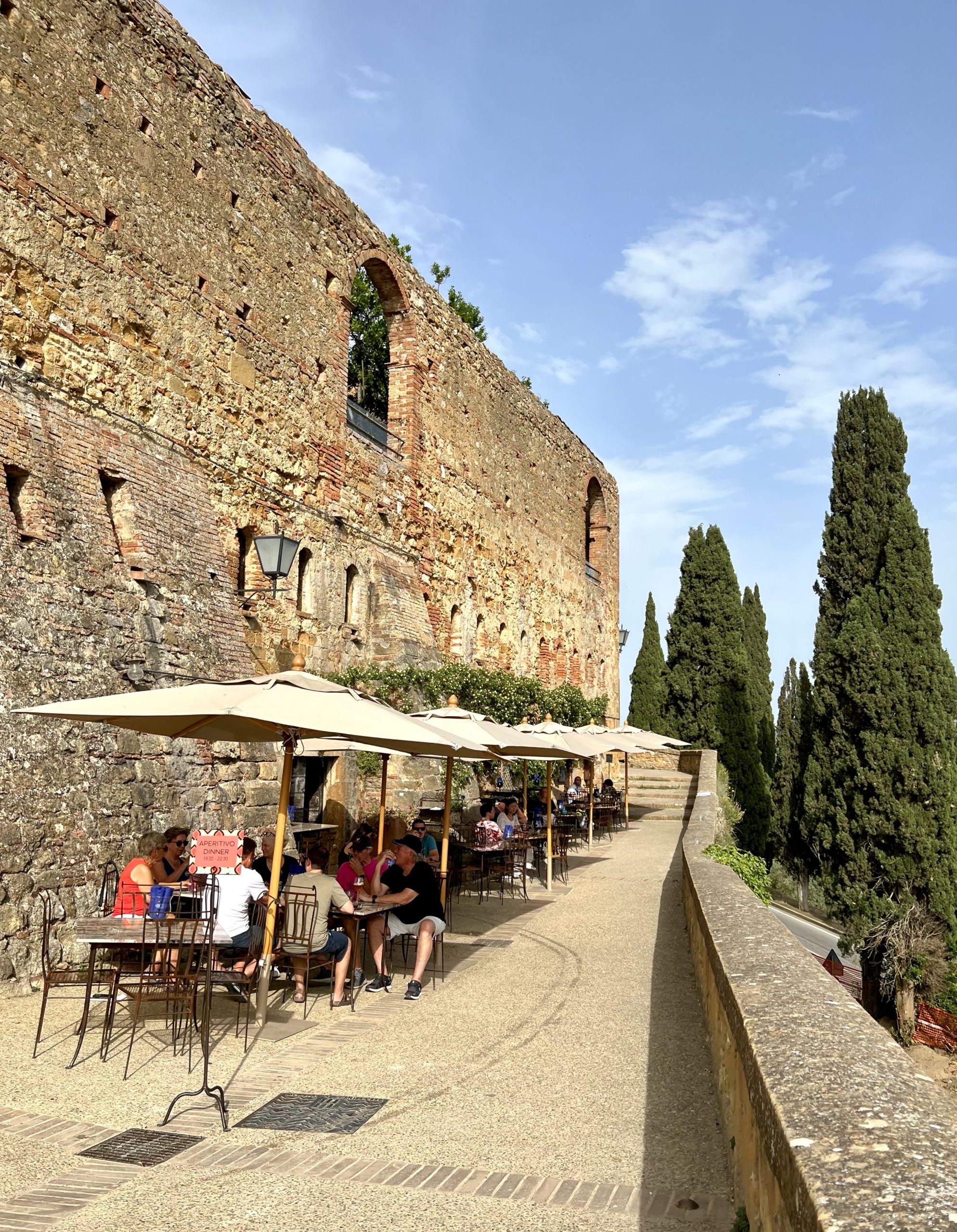
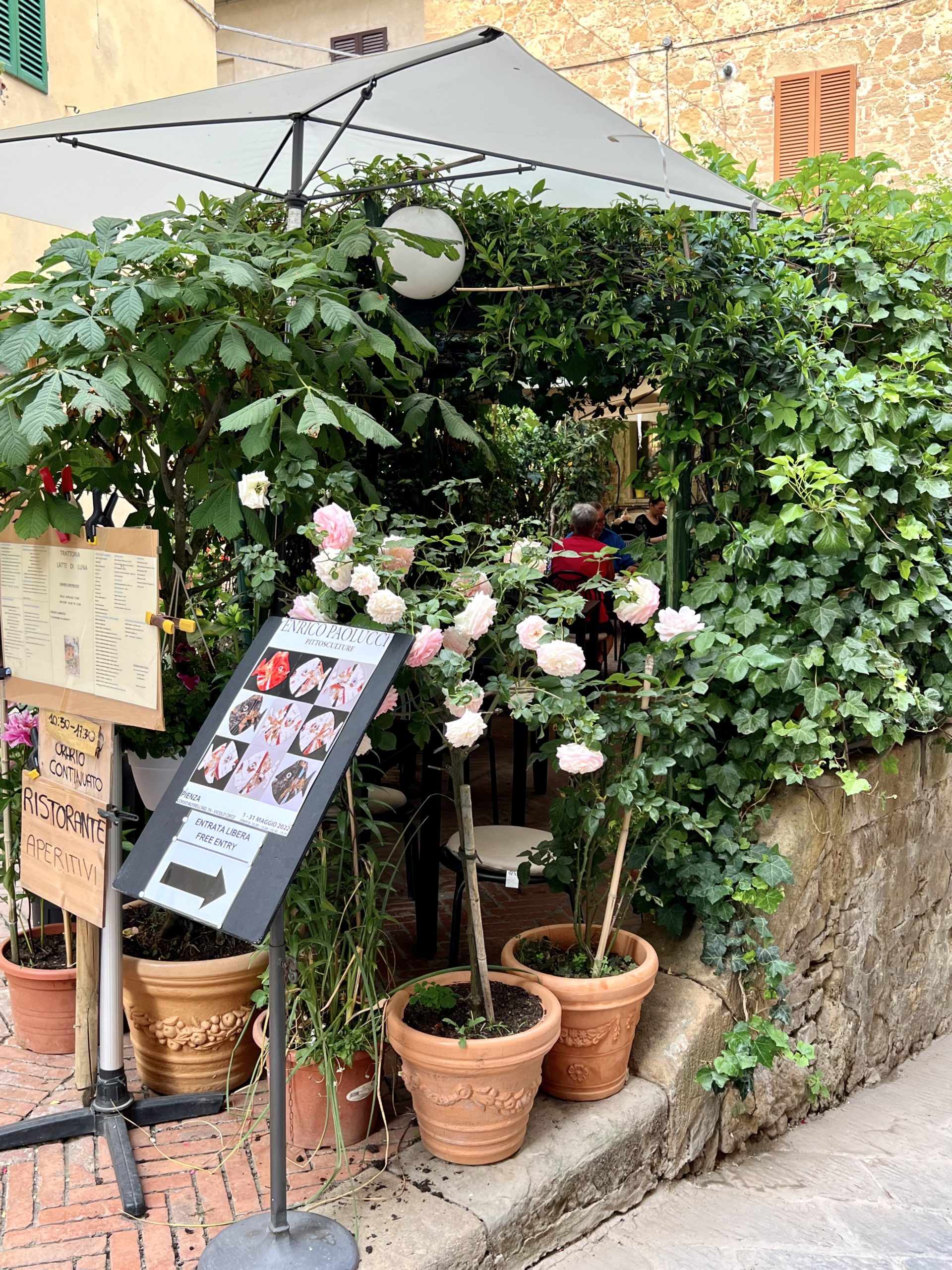
What And Where To Eat in Pienza
Pienza is known for its delicately flavored Pecorino cheese. This sacred Italian cheese is made from sheep’s milk.
Plenty of shops hawking this delicacy are tucked away in the narrow streets. There are wheels and wheels of it, both creamy and blackened with age.
Need to eat in Pienza? Try Trattoria Latte di Luna on the Corso Rossellini, one of Pienza’s main streets (connecting the town gates). It’s a tiny restaurant inside a rose garden.
You can also try Osteria Baccus on Via del Casello. For sweeping views of the Val d’Orcia, pop into La Terrazzo del Chiostro Restaurant.
For gelato, head to Gelataria Artigianal. You can even try gelato made with pecorino cheese.
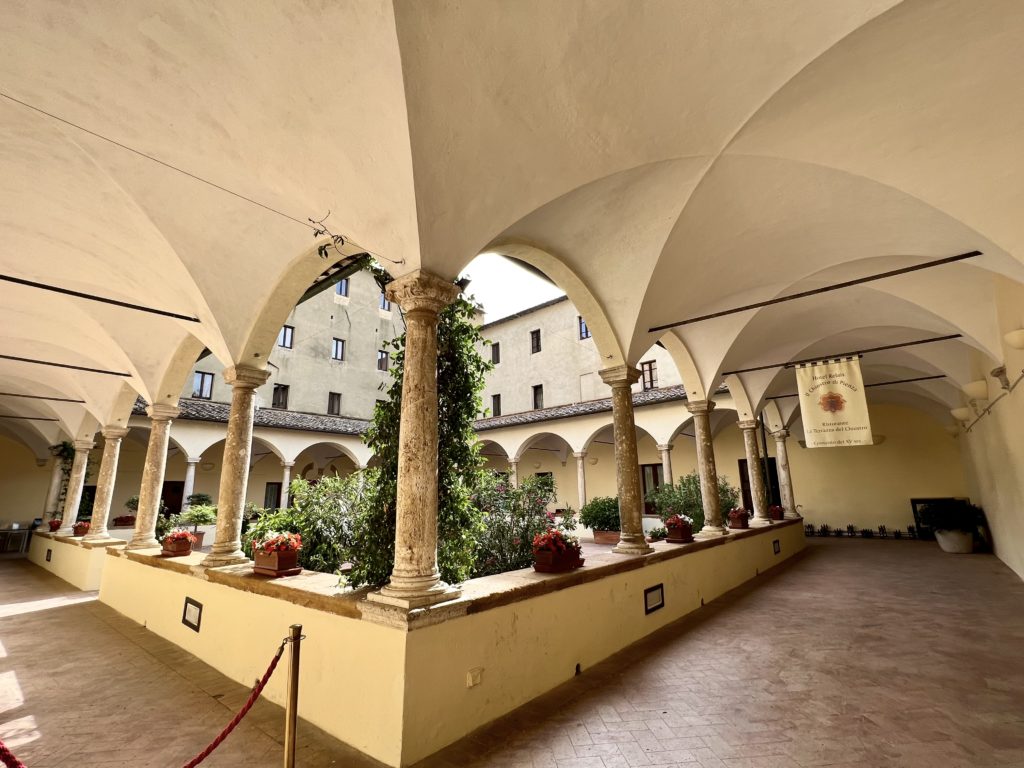
Where To Stay in Pienza
There are some good hotel options in Pienza. You can try La Bandita Townhouse, which is in a former convent with a modern design aesthetic and stone walls.
Hotel Corsignano is a romantic place near the monuments.
The Relais II Chiostro di Pienza is also housed in a former convent with a cloister and fantastic views.
I hope you’ve enjoyed my guide to the best things to do in Pienza. You may enjoy these other Tuscany travel guides:
- 10 day itinerary for Tuscany
- 1 day itinerary for Florence
- 3 day itinerary for Florence
- Best museums in Florence
- Hidden gems in Florence
- Best day trips from Florence
- 30 beautiful towns in Italy
- Art lover’s guide to Tuscany
- Guide to the Uffizi Gallery
- Best things to do In San Gimignano
- 1 day in Siena itinerary
If you’d need a guide to the beautiful town of Pienza, pin it for later.

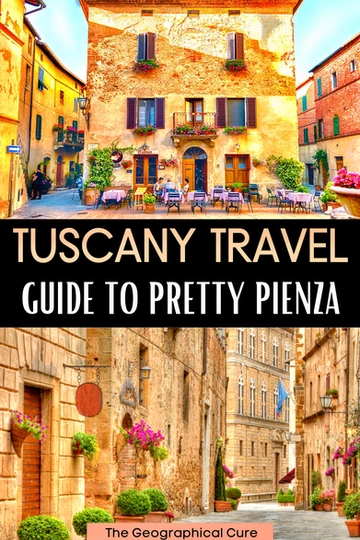
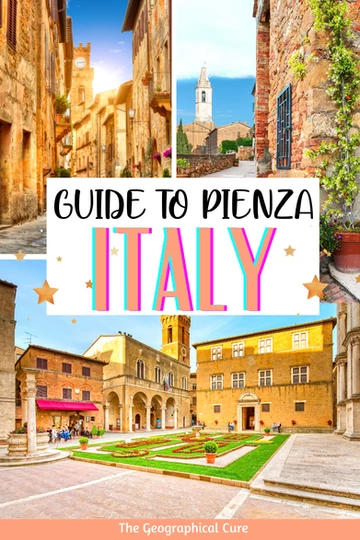
Excellent information well researched thanks!
Look forward to our trip there shortly.
Thank you. Enjoy Pienza!